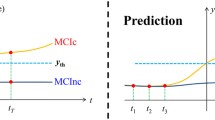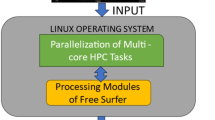Abstract
Alzheimer’s Disease (AD) is a neurological disorder that leads to a loss of cognitive functioning, affecting older people as well as their families. Although a few treatments are available to slow down the progress of the disease, they are limited in effectiveness and should start at an early stage of the disease. Since an early diagnosis of AD is crucial, to maximize treatment effectiveness and prepare the families for the worsening of symptoms, researchers are studying biomarkers and Computer-aided diagnosis (CAD) systems. Hence, this manuscript proposes a new methodology to obtain an efficient CAD system by relying on [\(^{18}\)F]-Fluorodeoxyglucose Positron Emission Tomography (FDG-PET) scans, while taking into account the longitudinal information of a subject. The CAD system tries to identify regions of interest by simultaneously segmenting all the FDG-PET scans acquired over time for each subject and combining the segmentation result to find the most coherent information for all the subjects. Experimental results show that the proposed CAD system outperforms a state-of-the-art approach, either when only relying on baseline scans or in the follow-up classification, achieving, for instance, more than 82.0% accuracy in the discrimination between AD and Mild Cognitive Impairment (MCI). Finally, in a multi-class classification task, the proposed CAD system attains 59.0% accuracy at baseline and goes up to 69.4% in the follow-up.











Similar content being viewed by others
Explore related subjects
Discover the latest articles, news and stories from top researchers in related subjects.References
Aidos H, Duarte J, Fred A (2014a) Finding coherent regions in PET images for the diagnosis of Alzheimer’s disease. In: Proceedings of the international conference on bioimaging (BIOIMAGING), pp 12–18
Aidos H, Duarte J, Fred A (2014b) Identifying regions of interest for discriminating Alzheimer’s disease from mild cognitive impairment. In: IEEE international conference on image processing (ICIP), pp 21–25
Arbeláez P, Maire M, Fowlkes C, Malik J (2011) Contour detection and hierarchical image segmentation. IEEE Trans Pattern Anal Mach Intell 33(5):898–916
Beucher S, Lantuejoul C (1979) Use of watersheds in contour detection. In: Proceedings of the international workshop on image processing, real-time edge and motion detection/estimation
Bicacro E, Silveira M, Marques JS, Costa DC (2012) 3D image-based diagnosis of Alzheimer’s disease: bringing medical vision into feature selection. In: IEEE international symposium on biomedical imaging: from nano to macro (ISBI), pp 134–137
Bron EE, Smits M, Niessen WJ, Klein S (2015a) Feature selection based on the SVM weight vector for classification of dementia. IEEE J Biomed Health Inform 19(5):1617–1626
Bron EE, Smits M, van der Flier WM, Vrenken H, Barkhof F et al (2015b) Standardized evaluation of algorithms for computer-aided diagnosis of dementia based on structural MRI: The CADDementia challenge. NeuroImage 111:562–579
Burt PJ (1981) Fast filter transform for image processing. Comput Graphics Image Process 16(1):20–51
Chaves R, Ramirez J, Gorriz JM, Lopez M, Alvarez I, Salas-Gonzalez D, Segovia F, Padilla P (2009) SPECT image classification based on NMSE feature correlation weighting and SVM. In: Proceedings of the IEEE nuclear science symposium conference record (NSS/MIC), pp 2715–2710
Chu C, Hsu A-L, Chou K-H, Bandettini P, Lin C (2012) Does feature selection improve classification accuracy? Impact of sample size and feature selection on classification using anatomical magnetic resonance images. NeuroImage 60:59–70
Duarte J, Aidos H, Fred A (2014) Feature extraction in PET images for the diagnosis of Alzheimer’s disease. In: Proceedings of the international conference on pattern recognition applications and methods (ICPRAM), pp 561–568
Ester M, Kriegel H-P, Sander J, Xu X (1996) A density-based algorithm for discovering clusters in large spatial databases with noise. In: Proceedings of the international conference on knowledge discovery and data mining (KDD), pp 226–231
Fan Y, Batmanghelich N, Clark C, Davatzikos C (2008) Spatial patterns of brain atrophy in MCI patients, identified via high-dimensional pattern classification, predict subsequent cognitive decline. NeuroImage 39:1731–1743
Gerardin E, Chételat G, Chupin M, Cuingnet R, Desgranges B, Kim H-S, Niethammer M, Dubois B, Lehéricy S, Garnero L, Eustache F, Colliot O (2009) Multidimensional classification of hippocampal shape features discriminates Alzheimer’s disease and mild cognitive impairment from normal aging. NeuroImage 47(4):1476–1486
Gray KR, Wolz R, Heckemann RA, Aljabar P, Hammers A, Rueckert D (2012) Multi-region analysis of longitudinal FDG-PET for the classification of Alzheimer’s disease. NeuroImage 60:221–229
Gupta A, Ayhan M, Maida A (2013) Natural image bases to represent neuroimaging data. In: Proceedings of the 30th international conference on machine learning (ICML), pp 987–994
James BD, Leurgans SE, Hebert LE, Scherr PA, Yaffe K, Bennett DA (2014) Contributions of Alzheimer disease to mortality in the United States. Neurology 82(12):1045–1050
Klein S, Loog M, van der Lijn F, den Heijer T, Hammers A, de Bruijne M, van der Lugt A, Duin R, Breteler M, Niessen W (2010) Early diagnosis of dementia based on intersubject whole-brain dissimilarities. In: 2010 IEEE international symposium on biomedical imaging: from nano to macro. IEEE, pp 249–252
Lee JA, Verleysen M (2007) Nonlinear dimensionality reduction. Springer, Information Science and Statistics, Berlin
Li F, Tran L, Thung K-H, Ji S, Shen D, Li J (2015) A robust deep model for improved classification of AD/MCI patients. IEEE J Biomed Health Inform 19(5):1610–1616
Liu S, Liu S, Cai W, Che H, Pujol S, Kikinis R, Feng D, Fulham MJ (2015) Multimodal neuroimaging feature learning for multiclass diagnosis of Alzheimer’s disease. IEEE Trans Biomed Eng 62(4):1132–1140
Lopez M, Ramirez J, Gorriz JM, Salas-Gonzalez D, Alvarez I, Segovia F, Chaves R (2009) Multivariate approaches for Alzheimer’s disease diagnosis using bayesian classifiers. In: Proceedings of the IEEE nuclear science symposium conference record (NSS/MIC), pp 3190–3193
McKhann GM, Knopman DS, Chertkow H, Hyman BT, Clifford J, Jack R, Kawas CH, Klunk WE, Koroshetz WJ, Manly JJ, Mayeux R, Mohs RC, Morris JC, Rossor MN, Scheltens P, Carillo MC, Thies B, Weintraub S, Phelps CH (2011) The diagnosis of dementia due to Alzheimer’s disease: recommendations from the National Institute on aging and the Alzheimer’s Association workgroup. Alzheimer’s and Dement 7(3):263–269
Mikhno A, Nuevo PM, Devanand DP, Parsey RV, Laine AF (2012) Multimodal classification of dementia using functional data, anatomical features and 3D invariant shape descriptors. In: Proceedings of IEEE international symposium on biomedical imaging (ISBI), pp 606–609
Misra C, Fan Y, Davatzikos C (2009) Baseline and longitudinal patterns of brain atrophy in MCI patients, and their use in prediction of short-term conversion to AD: Results from ADNI. NeuroImage 44(4):1415–1422
Morgado P, Silveira M, Marques JS (2013) Efficient selection of non-redundant features for the diagnosis of Alzheimer’s disease. In: Proceedings of IEEE international symposium on biomedical imaging: from nano to macro (ISBI), pp 640–643
Pagani M, Carli FD, Morbelli S, Öberg J, Chincarini A, Frisoni G, Galluzzi S, Perneczky R, Drzezga A, van Berckel B, Ossenkoppele E, Didic M, Guedj E, Brugnolo A, Picco A, Arnaldi D, Ferrara M, Buschiazzo A, Sambuceti G, Nobili F (2015) Volume of interest-based [\(^{18}\)F]fluorodeoxyglucose PET discriminates MCI converting to Alzheimer’s disease from healthy controls. A European Alzheimer’s disease consortium (EADC) study. NeuroImage Clin 7:34–42
Park H (2012) ISOMAP induced manifold embedding and its application to Alzheimer’s disease and mild cognitive impairment. Neurosci Lett 513(2):141–145
Park H, Seo J (2011) Application of multidimensional scaling to quantify shape in Alzheimer’s disease and its correlation with mini mental state examination: a feasibility study. J Neurosci Methods 194(2):380–385
Petersen RC (2004) Mild cognitive impairment as a diagnostic entity. J Intern Med 256(3):183–194
Qian B, Wang X, Cao N, Li H, Jiang Y-G (2015) A relative similarity based method for interactive patient risk prediction. Data Min Knowl Discov 29(4):1070–1093
Ramírez J, Górriz JM, Salas-Gonzalez D, Romero A, López M, Álvarez I, Gómez-Río M (2013) Computer-aided diagnosis of Alzheimer’s type dementia combining support vector machines and discriminant set of features. Inf Sci 237:59–72
Segovia F, Górriz JM, Ramírez J, Salas-Gonzalez D, Álvarez I, López M, Chaves R (2012) A comparative study of feature extraction methods for the diagnosis of Alzheimer’s disease using the ADNI database. Neurocomputing 75:64–71
Tran TN, Nguyen TT, Willemsz TA, van Kessel G, Frijlink HW, van der Voort Maarschalk K (2012) A density-based segmentation for 3D images, an application for X-ray micro-tomography. Anal Chim Acta 725:14–21
Tripathi S, Kumar K, Singh BK, Singh RP (2012) Image segmentation: a review. Int J Comput Sci Manag Res 1(4):838–843
Varma S, Simon R (2006) Bias in error estimation when using cross-validation for model selection. BMC Bioinform 7:91
Weuve J, Hebert LE, Scherr PA, Evans DA (2014) Deaths in the United States among persons with Alzheimer’s disease (2010–2050). Alzheimer’s and Dement 10(2):e40–e46
Ye J, Farnum M, Yang E, Verbeeck R, Lobanov V, Raghavan N, Novak G, DiBernardo A, Narayan V (2012) Sparse learning and stability selection for predicting MCI to AD conversion using baseline ADNI data. BMC Neurol 12:46
Yun HJ, Kwak K, Lee J-M, Alzheimer’s Disease Neuroimaging Initiative (2015) Multimodal discrimination of Alzheimer’s disease based on regional cortical atrophy and hypometabolism. PloS One 10(6):e0129250. doi:10.1371/journal.pone.0129250
Zhang D, Wang Y, Zhou L, Yuan H, Shen D (2011) Multimodal classification of Alzheimer’s disease and mild cognitive impairment. NeuroImage 55(3):856–867
Zhu X, Suk H-I, Lee S-W, Shen D (2016a) Canonical feature selection for joint regression and multi-class identification in Alzheimer’s disease diagnosis. Brain Imaging Behav 10(3):818–828
Zhu X, Suk H-I, Lee S-W, Shen D (2016b) Subspace regularized sparse multitask learning for multiclass neurodegenerative disease identification. IEEE Trans Biomed Eng 63(3):607–618
Acknowledgements
This work was supported by the Portuguese Foundation for Science and Technology, under Scholarship Number SFRH/BPD/103127/2014 and Grants PTDC/EEI-SII/7092/2014 and PTDC/EEI-SII/1937/2014. Data collection and sharing for this project was funded by the Alzheimer’s Disease Neuroimaging Initiative (ADNI) (National Institutes of Health Grant U01 AG024904) and DOD ADNI (Department of Defense Award Number W81XWH-12-2-0012). ADNI is funded by the National Institute on Aging, the National Institute of Biomedical Imaging and Bioengineering, and through generous contributions from the following: AbbVie, Alzheimers Association; Alzheimers Drug Discovery Foundation; Araclon Biotech; BioClinica, Inc.; Biogen; Bristol-Myers Squibb Company; CereSpir, Inc.; Eisai Inc.; Elan Pharmaceuticals, Inc.; Eli Lilly and Company; EuroImmun; F. Hoffmann-La Roche Ltd and its affiliated company Genentech, Inc.; Fujirebio; GE Healthcare; IXICO Ltd.; Janssen Alzheimer Immunotherapy Research & Development, LLC.; Johnson & Johnson Pharmaceutical Research & Development LLC.; Lumosity; Lundbeck; Merck & Co., Inc.; Meso Scale Diagnostics, LLC.; NeuroRx Research; Neurotrack Technologies; Novartis Pharmaceuticals Corporation; Pfizer Inc.; Piramal Imaging; Servier; Takeda Pharmaceutical Company; and Transition Therapeutics. The Canadian Institutes of Health Research is providing funds to support ADNI clinical sites in Canada. Private sector contributions are facilitated by the Foundation for the National Institutes of Health (www.fnih.org). The grantee organization is the Northern California Institute for Research and Education, and the study is coordinated by the Alzheimer’s Disease Cooperative Study at the University of California, San Diego. ADNI data are disseminated by the Laboratory for Neuro Imaging at the University of Southern California.
Author information
Authors and Affiliations
Consortia
Corresponding author
Additional information
Responsible editor: Pierre Baldi.
The source code of the proposed algorithm is available at http://camoes.lx.it.pt/pia/FU_CAD_toolbox.zip.
Data used in the preparation of this article were obtained from the Alzheimers Disease Neuroimaging Initiative (ADNI) database (adni.loni.usc.edu). As such, the investigators within the ADNI contributed to the design and implementation of ADNI and/or provided data but did not participate in analysis or writing of this report. A complete listing of ADNI investigators can be found at: http://adni.loni.usc.edu/wp-content/uploads/how_to_apply/ADNI_Acknowledgement_List.
Rights and permissions
About this article
Cite this article
Aidos, H., Fred, A. & For the Alzheimer’s Disease Neuroimaging Initiative. Discrimination of Alzheimer’s Disease using longitudinal information. Data Min Knowl Disc 31, 1006–1030 (2017). https://doi.org/10.1007/s10618-017-0502-5
Received:
Accepted:
Published:
Issue Date:
DOI: https://doi.org/10.1007/s10618-017-0502-5




